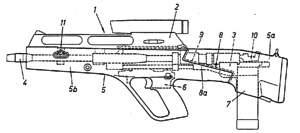Steyr ACR
| Steyr ACR | |
|---|---|
 Steyr Advanced Combat Rifle entry | |
| Type | Assault rifle |
| Place of origin | |
| Service history | |
| Used by | |
| Production history | |
| Designer | Ulrich Zedrosser |
| Designed | 1987 |
| Manufacturer | Steyr Mannlicher |
| Specifications | |
| Mass | Template:Lb to kgunloaded |
| Length | Template:In to mm |
| Barrel length | Template:In to mm |
| Cartridge | 5.56x45mm annular-primed SCF (synthetic case flechette) |
| Action | gas-operated, vertically-sliding chamber |
| Rate of fire | Semi automatic, 3-round burst at 2200rpm cyclic[1] |
| Muzzle velocity | 4,757 ft/s (1,450 m/s) |
| Feed system | 24-round box magazine |
The Steyr ACR was a prototype flechette-firing assault rifle built for the US Army's Advanced Combat Rifle program of 1989/90. Although the Steyr design proved effective, as did most of the weapons submitted, the entire ACR program ended with none of the entrants achieving performance 100% better than the M16A2, the baseline for a successful ACR weapon.
Design
The Steyr ACR has some superficial resemblance to the Steyr AUG, although it is rounder and the barrel is covered for almost its entire length, as opposed to the AUG where much of the barrel was exposed. Like the AUG the ACR is a bullpup design with the 24-round magazine located quite close to the buttstock of the gun. The stock was "split" from the magazine forward to a location just below the sights to open for cleaning. An optical sight was included as a standard feature.
The Steyr employed a unique system to cycle through ammunition: instead of driving rounds forward into the chamber and being held in place by a locking bolt, the entire chamber traveled vertically the width of the round. After firing the gases "blew" the chamber vertically downward where a new round was forced into the chamber from the rear, forcing the old round out an ejection port ahead of the magazine. Springs then raised the chamber back into position where it was locked into a fixed block. The firing pin was fixed above the chamber, entering through a small hole and striking the ring of primer to fire. The chamber was normally held in the "down" position, the trigger releasing it to allow the springs to drive it upward and fire.
Ammunition
The Steyr ACR's rounds consist of a carbon steel flechette for a projectile that used a four part spindle sabot packaged in a telescoped arrangement with propellant packed around the projectile. The case of the ammunition was made of a light weight translucent plastic instead of conventional brass making the rounds weigh less than half the weight of standard 5.56x45mm NATO ammunition.
Performance
During testing the weapon performed well, and only two problems were identified. One was that the plastic casings had varying strengths, which has some effect on the ballistics. This was considered to be a fairly minor problem, one they expected could be solved through better materials and quality control. The other issue was somewhat more difficult to solve; when the sabots left the barrel they were still going quite fast, and presented a danger to other soldiers as well as to the shooter if they bounced off the ground when firing prone.
Patents
Rifle
U.S. patent 4,739,570
U.S. patent 4,760,663
U.S. patent 4,817,496
U.S. patent 4,930,241
U.S. patent 4,944,109
U.S. patent 4,949,493
Ammunition
U.S. patent 4,846,068
U.S. patent 4,848,237
U.S. patent 4,928,597
See also
- Colt ACR
- HK ACR
- Special Purpose Individual Weapon
- Steyr AMR 5075/Steyr IWS 2000 prototype long range sniper rifle fires similar but larger rounds
- Polymer-cased ammunition
